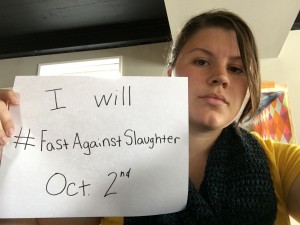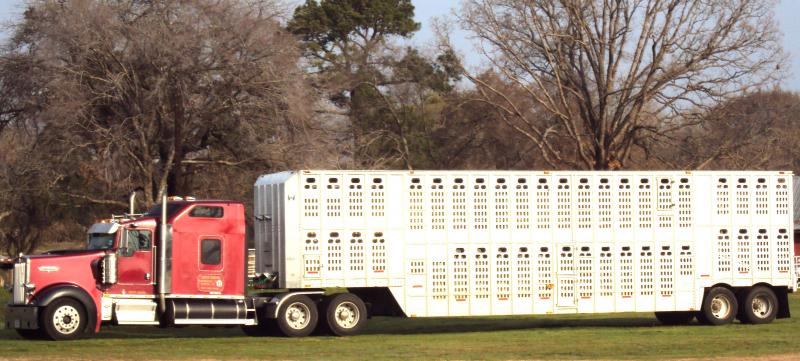Last week I spent many hours driving through rural Illinois. I was on roads completely surrounded by grain fields, many of which had been harvested. Most of the vehicles I saw were transportation trucks for those grains. Those are relatively easy to spot because they tend to have fabric covers on top instead of being fully enclosed like most semi-trucks on the road.
Then I began to notice a few empty animal transportation trucks. These are especially easy to spot because they are metal and have many oval holes. Even when they’re empty, seeing them makes me feel like my heart stopped for a moment…
They were all coming from the same direction. I looked at my map to see I would remain on this road for around 30 miles; I knew I’d probably see where the trucks are coming from eventually.
Among the animal transportation trucks were even more grain trucks. This makes sense because the “7 billion livestock animals in the United States consume five times as much grain as is consumed directly by the entire American population” [1]. A single pig on one of those trucks headed to a slaughterhouse will consume an average of 6 to 8 pounds of feed a day for her short 6 months of life [2].
Eventually I saw the place where the trucks had just finished their business.
 It was a big building with space for trucks to unload, a door for people to enter, and no other openings that I could see. According to Every Twelve Seconds by Timothy Pachirat, the building likely had a “clean entrance” and “dirty entrance” for workers who touch the animals before and after they are killed and cleaned. This is the first time I saw a slaughterhouse, and even reading Every Twelve Seconds didn’t prepare me for the reality of being so close to one.
It was a big building with space for trucks to unload, a door for people to enter, and no other openings that I could see. According to Every Twelve Seconds by Timothy Pachirat, the building likely had a “clean entrance” and “dirty entrance” for workers who touch the animals before and after they are killed and cleaned. This is the first time I saw a slaughterhouse, and even reading Every Twelve Seconds didn’t prepare me for the reality of being so close to one.
There was a big gravel lot with unoccupied transportation trucks. I also saw what appeared to be a food cart with a line of truck drivers waiting to order. I’m going to take a guess and say that food cart wasn’t vegetarian friendly.
Could you imagine dropping off a few hundred animals to be slaughtered and then turning around to eat the bodies of those left there yesterday?
I’m not really sure how to describe how I felt. My hands were shaking, my breaths were short, I was holding back tears so I could drive safely. I had a thick, full feeling in my throat. Now matter how I felt, it was nothing compared what those animals will feel when they get to the “knocker”.
I see CAFOs (Concentrated Animal Feeding Operation) frequently because they’re all over Indiana, especially on I-65, which I take going to and from Chicago. They’re easy to miss if you’re not looking for them. Rarely are CAFOs close to main roads. There are many reasons for this, of course to keep them out of sight and out of mind, but also because the smell of millions of animals feces leads to a lot of complaints. By putting them off main roads and in more rural, poor areas, those complaints don’t matter as much. I also see a Tyson facility every time I go to Uplands PEAK Animal Sanctuary. I am reminded as I approach it because there are usually feathers strewn about the sides of the road.
I created the following graphic for Uplands PEAK to show how many CAFOs operate in Indiana.

Most people working in this industry don’t choose it. Slaughterhouse workers are usually immigrants. The turnover rate is very high, anywhere from 75% to 100% each year [3]. Most people would desire a decent wage for this gruesome and dangerous work, but they won’t find it. Immigrants and very poor Americans do the work for cheap, allowing privileged people to comfortably eat cheap meat that has been removed of most evidence that “it” was once a “who”.
This, all of this, is why I’m fasting against slaughter. The hundreds of animals I saw on those trucks, and the billions of animals who do not eat on their final day to the slaughterhouse.
In one year, 9 billion land animals will be slaughtered just in the United States [4], so that people may eat their carcasses. That’s just land animals. When you include fish, the number jumps to 59 billion [5]. 59 billion lives taken in a single year, in the United States.
So, on October 2nd I will abstain from food for at least 18 hours. This will be my first time fasting, which is why I choose slightly less than 24. If I feel like I can make it the full day I absolutely will.
If you would like to get a glimpse at the experience of the final day before slaughter, see the videos by Toronto Pig Save. They hold vigils for the pigs transported through Toronto every day.
[1] http://www.news.cornell.edu/stories/1997/08/us-could-feed-800-million-people-grain-livestock-eat
[2] http://www.epicurious.com/archive/blogs/editor/2008/08/from-pig-to-por.html
[3] http://www.pbs.org/wgbh/pages/frontline/shows/meat/slaughter/slaughterhouse.html
[4] http://www.humanesociety.org/news/resources/research/stats_slaughter_totals.html
[5] http://freefromharm.org/farm-animal-welfare/59-billion-land-and-sea-animals-killed-for-food-in-the-us-in-2009/
